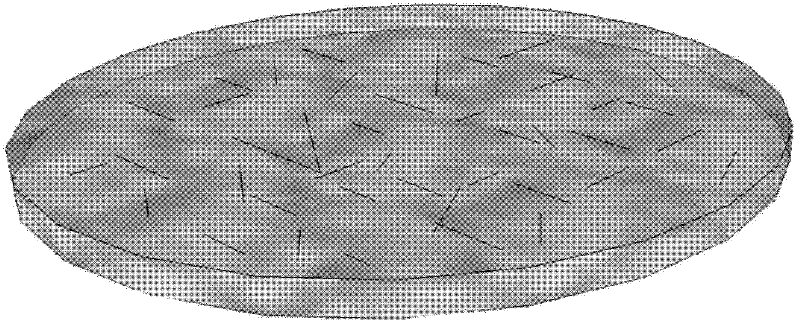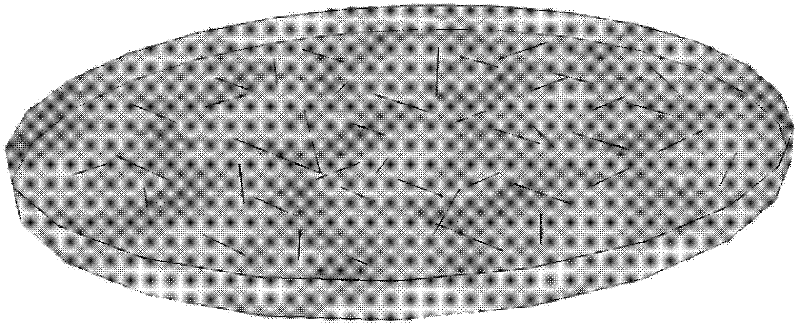Oxidized sodium alginate/gelatin degradable hydrogel and preparation method thereof
A technology for oxidizing sodium alginate and hydrogel, which is used in medical science, absorbent pads, bandages, etc. to achieve the effects of good compatibility, excellent absorbability and simple operation
- Summary
- Abstract
- Description
- Claims
- Application Information
AI Technical Summary
Problems solved by technology
Method used
Image
Examples
Embodiment 1
[0032] (1) Take a number of PLA slices and dry them under vacuum at 100°C for 8 hours; then melt and extrude them through a screw extruder to obtain PLA primary multifilament fibers; after stretching, obtain PLA stretched fibers with a single filament diameter of 0.05mm, the number of multifilaments is 12; the fibers are cut into short fibers with an average length of 4mm.
[0033] (2) Weigh sodium alginate with a balance and configure a solution with a mass fraction of 2% with distilled water; add potassium permanganate solution to make the concentration of potassium permanganate in the solution reach 5 × 10 -4 mol / L; use hydrochloric acid to adjust the pH of the solution to 3; stir in a dark room at room temperature for 10 minutes to fully oxidize; add 0.3% NaCl to the solution, and extract the oxidized sodium alginate with ethanol.
[0034] (3) Weigh the gelatin with a balance and add it to distilled water, fully swell for 45 minutes, stir in a warm water bath at 60°C until...
Embodiment 2
[0038] (1) Take a number of PGLA slices and dry them under vacuum at 90°C for 15 hours; then melt and extrude them through a screw extruder to obtain PGLA primary single fibers; after stretching, obtain PGLA stretched single fibers with a diameter of 0.1 mm, the single fiber was cut into staple fibers with an average length of 3 mm long.
[0039] (2) Weigh sodium alginate with a balance and configure a solution with a mass fraction of 2% with distilled water; add potassium permanganate solution to make the concentration of potassium permanganate in the solution reach 5 × 10 -4 mol / L; use hydrochloric acid to adjust the pH of the solution to 3; stir in a dark room at room temperature for 10 minutes to fully oxidize; add 0.3% NaCl to the solution, and extract the oxidized sodium alginate with ethanol.
[0040] (3) Weigh the gelatin with a balance and add it to distilled water, fully swell for 45 minutes, stir in a warm water bath at 60°C until it is completely dissolved, and prepa...
Embodiment 3
[0044] (1) Take a number of PBS slices and dry them under vacuum at 80°C for 10 hours; then melt and extrude them through a screw extruder to obtain PBS primary single fibers; after stretching, obtain PBS stretched single fibers with a diameter of 0.05 mm; the monofilaments were cut into short fibers with an average length of 4 mm long.
[0045] (2) Weigh sodium alginate with a balance and configure a solution with a mass fraction of 2% with distilled water; add potassium permanganate solution to make the concentration of potassium permanganate in the solution reach 5 × 10 -4 mol / L; use hydrochloric acid to adjust the pH of the solution to 3; stir in a dark room at room temperature for 10 minutes to fully oxidize; add 0.3% NaCl to the solution, and extract the oxidized sodium alginate with ethanol.
[0046] (3) Weigh the gelatin with a balance and add it to distilled water, fully swell for 45 minutes, stir in a warm water bath at 60°C until it is completely dissolved, and prep...
PUM
 Login to View More
Login to View More Abstract
Description
Claims
Application Information
 Login to View More
Login to View More - R&D
- Intellectual Property
- Life Sciences
- Materials
- Tech Scout
- Unparalleled Data Quality
- Higher Quality Content
- 60% Fewer Hallucinations
Browse by: Latest US Patents, China's latest patents, Technical Efficacy Thesaurus, Application Domain, Technology Topic, Popular Technical Reports.
© 2025 PatSnap. All rights reserved.Legal|Privacy policy|Modern Slavery Act Transparency Statement|Sitemap|About US| Contact US: help@patsnap.com


